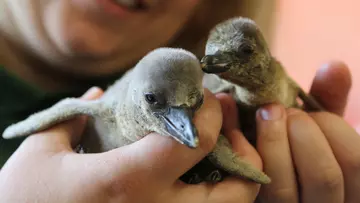
What do penguins look like?
Humboldts are medium-sized penguins. They have black heads with a white stripe on either side and pink skin around their eyes and base of the bill.

Humboldt penguin facts
- These penguins need to lose heat, rather than conserve it. Bare patches beside their bills and large wings help do this.
- Humboldt penguins preen themselves and other members of the colony; they gather oil from a gland in their tail and apply it to their feathers like a gel.
- Humboldt penguins never chew with their mouth open because they don’t chew at all! Instead our penguins swallow their fish head first.
- A Humboldt penguin can reach up to 30 miles per hour in the water!
Whipsnade Zoo rockhopper penguins

What do Humboldt penguins eat?
Small fish and crustaceans

Humboldt penguin habitat
At sea, but nests on rocky coasts, burrowing holes in guano and also using scrape nests or caves.

Where do Humboldt penguins live?
Coastal Peru and Chile.
Can penguins fly?
Penguins can't fly, and on land they are known and loved for their clumsy waddles – but when it comes to swimming, they gracefully “fly” through the water.
Penguin wings are actually paddle-like flippers used for swimming. The motion of the flippers resembles the wing movements of flying birds, giving penguins the appearance of flying through water. The wing and breast muscles are well developed, to propel penguins through water - a medium much denser than air.
Humboldt penguin threats
Numbers in the wild are declining. They are at risk from disturbance of colonies by Guano harvesting. Guano (penguin droppings) is a valuable fertiliser and is harvested periodically from many colonies. They are also threatened by pollution from oil spills, overfishing, and habitat loss. Humboldt penguins are hunted by seals, sealions and sharks.
From the fresh pitter patter of tiny feet to massive new arrivals, get the latest Zoo news straight into your inbox.
